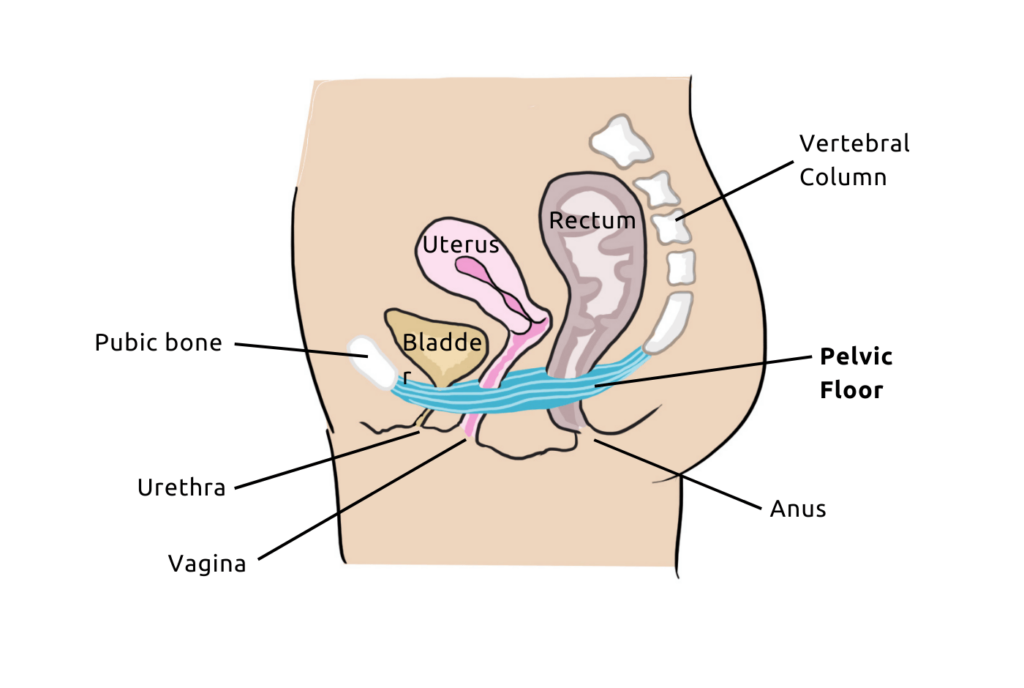
How to prevent prolapse after childbirth?
The pelvic floor is a set of muscles put to the test during pregnancy and also during the delivery of the baby. The main consequences of a relaxed pelvic floor are the onset of urinary leaks and/or organ prolapse after childbirth. How to avoid these discomforts after pregnancy?
Factors impacting the pelvic floor during pregnancy
When you are pregnant, you hear about many different subjects, including the pelvic floor , also called the pelvic floor. It ensures the support of the genital organs and is involved in processes of continence and sexual response.
But did you know that your pelvic floor has likely been weakened during these 9 months of pregnancy and also during childbirth? A weakened pelvic floor can have numerous consequences on the body.

Effects of pregnancy on the pelvic floor
Many factors can impact perineal tone during pregnancy such as:
- the size and weight of the baby;
- hormonal changes;
- abdominal pressure;
- softening of tissues and ligaments;
- etc.

Effects of childbirth on the pelvic floor
In addition to pregnancy, childbirth itself will also have effects on perineal tone. The duration of labor, the use of instruments, the size and weight of the baby, or an episiotomy can have significant consequences on your pelvic floor.

It is true that vaginal delivery often causes more damage to the pelvic floor . We often mistakenly believe that during a cesarean delivery, the pelvic floor is not affected.
However, the weight of the baby during the 9 months is also significant and can contribute to a relaxation of the pelvic floor muscles, even in the case of a cesarean delivery!

After all these morphological changes undergone by the body after pregnancy and childbirth, it is possible that the pelvic organs are no longer properly supported by the pelvic floor. Urinary leaks or organ prolapse may then occur after childbirth.
Do kegels for your pelvic floor
What are the symptoms of organ prolapse after childbirth?
There are several stages of organ prolapse, also called prolapse. According to the classification of Baden-Walker, there are 4 grades depending on whether the organ prolapse is at an early or advanced stage.
The latter corresponds to the stage during which a part of the organs literally protrudes from the body. Some symptoms can alert you and suggest the onset of organ prolapse.
The presence of a lump at the level of the vulva
The presence of a lump at the vaginal level can be a sign, as well as the appearance of a feeling of heaviness in the lower abdomen. This is often manifested by discomfort.

Appearance of urinary leaks
The appearance of urinary leaks, difficulty in urinating, or too frequent urination can also alert to the potential presence of early prolapse after childbirth.
Absence of sensations during sexual intercourse
Pelvic pain or absence of sensations during postpartum intercourse can also alert you to a dysfunction, possibly related to organ prolapse.

Presence of gas or stool leaks
Finally, if you experience anal incontinence, this could also be a sign of pelvic organ prolapse. These symptoms can occur quickly after childbirth but also several months or years later!

Other symptoms can also be indicative of pelvic organ prolapse after childbirth. It is important not to ignore their onset and to seek prompt attention.
What to do in case of prolapse after childbirth?
Your first step when feeling discomfort or symptoms potentially related to pelvic organ prolapse should be to consult a healthcare professional. Through a clinical examination, they can confirm the diagnosis of pelvic organ prolapse.

The treatment of prolapse depends on various factors such as its development stage, the age of the patient, and the discomfort experienced.
Your healthcare professional will likely recommend pelvic floor rehabilitation sessions post-birth. These sessions are greatly beneficial to prevent the onset or treat the initial symptoms of pelvic organ prolapse.
Pelvic floor rehabilitation to treat pelvic organ prolapse after childbirth
Indeed, post-pregnancy pelvic floor rehabilitation sessions can help reduce symptoms related to pelvic organ prolapse. Pelvic floor rehabilitation is always the first-line treatment for prolapse.
In 40 to 50% of cases, pelvic floor rehabilitation is even sufficient to correct the symptoms of pelvic organ prolapse.
Monitoring the evolution of your symptoms
Remember that monitoring the evolution of symptoms of prolapse is important. This information is valuable for your healthcare professional to support you effectively. Symptom evolution is often related to the progression of the condition.

If you experience occasional discomfort, using a pessary may be considered. On the contrary, if the discomfort persists, surgery may be proposed to you.
How to prevent organ prolapse after childbirth?
The first symptoms of prolapse can occur much later after childbirth, months, or even years later. To prevent organ prolapse after pregnancy, it is better to focus on prevention!

Performing postpartum pelvic floor rehabilitation
Doing postnatal pelvic floor rehabilitation is essential. These sessions help tone the pelvic floor muscles so that they regain their initial support and maintenance role. This also helps to prevent urinary leaks.
You can do your perineal rehabilitation with a healthcare professional and also continue to strengthen your pelvic floor with maintenance exercises at home. Whether between rehabilitation sessions or after completing the cycle with your professional, regular pelvic floor toning is necessary to prevent discomfort.

Continuing to maintain your pelvic floor at home
The pelvic floor is a group of muscles and like any other muscle in the body, it needs to be maintained and regularly strengthened throughout life.
Many healthcare professionals recommend the Emy connected kegel trainer whose effectiveness is clinically proven. It is a practical solution that allows you to continue to tone your pelvic floor at home at your own pace.

Thanks to its innovative biofeedback technology, the Emy probe allows you to visualize in real time its contractions on your smartphone.
Funny exercises based on medical protocols used in practices help work the different muscle fibers of the pelvic floor by alternating contractions and releases for overall muscle strengthening.

And most importantly, to make sure you stay consistent, the Emy solution allows you to track your progress and schedule reminders so you don’t forget to train regularly.

Free Pelvic floor guide
Find out how to strengthen your pelvic floor to prevent bladder weakness and improve intimate pleasure! 💥
Follow the recommendations of healthcare professionals
In addition to regularly training your pelvic muscles, it is recommended to apply some daily tips to preserve and protect your pelvic floor.
For example, avoid lifting heavy loads, especially during the postpartum period. Also, try not to resume sports activities too quickly after childbirth. And above all, do not resume sports before completing your postnatal rehabilitation!

By following these basic rules and adopting a healthy lifestyle, you will help your pelvic floor and your body regain its initial tone and avoid leaks and organ descent in the long term!

Also remember that childbirth is not the only risk factor for developing organ descent. Prevalence increases with age and tissue aging.
The pelvic floor, like all the muscles in our body, is a set of muscles that need to be kept toned and taken care of. It is important to protect it throughout life, not just after childbirth, to prevent organ descent.


